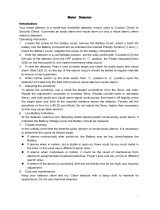
Getting Started | 15
1. LCD
Displays detector settings, options, and detection
information (page16).
2. MD Button
Long‑press from the Detect Screen to Enable or
Disable the MD Sensor.
Short‑press from the Detect Screen to display MD
Sensitivity adjustment (page35).
Short‑press from the Setup Screen to display the
MD Sensor feedback settings (page25).
3. Ground Balance Button
Short‑press to initiate MD Ground Balance
(page32).
Long‑press to initiate MD Noise Cancel (page34).
4. MD Target Indicator LEDs (Visual and IR)
Red LEDS indicate MD detection signal strength,
increasing from left to right.
The LEDs can transmit both visible light, and Infra‑
red for compatibility with Night Vision Imaging
Systems (NVIS).
5. Setup Button
Short‑press to display the Setup Screen to adjust
the general detector settings and MD and GPR
Sensor Feedback settings.
Long‑press (1.5s) to turn the detector On and Off.
6. Play/Pause Button
Short‑press to Pause/Play the GPR Image and/
or MD Trace (disables both MD and GPR Sensor
transmitters temporarily when paused.)
Brightness adjustment is only accessible from the
Pause Screen, using the Plus and Minus buttons to
adjust (page24).
Long‑press to turn the LCD On and Off.
7. Minus Button
Short‑press from the Detect Screen to display and
decrease the detector Volume level (page27).
Short‑press at the same time as the Plus button to
enable Night Vision Mode (page24).
Short‑press from the Pause Screen to display and
decrease the LCD brightness level (page24).
Short‑press to decrease the value of a selected
detector setting by one level.
8. Plus Button
Short‑press from the Detect Screen to display and
increase the detector Volume level (page27).
Short‑press at the same time as the Minus button to
enable Night Vision Mode (page24).
Short‑press from the Pause Screen to display and
increase the LCD brightness level (page24).
Short‑press to increase the value of a selected
detector setting by one level.
9. GPR Target Indicator LEDs
Yellow LEDS indicate GPR detection signal strength,
increasing from left to right.
The LEDs can transmit both visible light, and Infra‑
red for compatibility with Night Vision Imaging
Systems (NVIS).
10. Skyshot Button
Short‑press to initiate a Skyshot calibration process
(page38).
Long‑press to display GPR Advanced Settings.
11. GPR Button
Long‑press from the Detect Screen to Enable or
Disable the GPR Sensor.
Short‑press from the Detect Screen to display GPR
Sensitivity adjustment (page39).
Short‑press from the Setup Screen to display the
GPR Sensor Feedback settings (page25).
12. Tactical Mode Buttons Reference
Quick‑reference showing the button press
combination to enable Tactical Mode (page26).
Press the Plus and Minus buttons at the same time.
13. Night Vision Mode Buttons Reference
Quick‑reference showing the button press
combination to enable Night Vision Mode
(page24).
Press the Setup button and the Trigger at the same
time.
14. Trigger (at rear of user interface)
Press and release to toggle between Interrogation
Mode and Detection Mode (page51).
Press and hold to enable Pinpoint Mode
(page50).




















